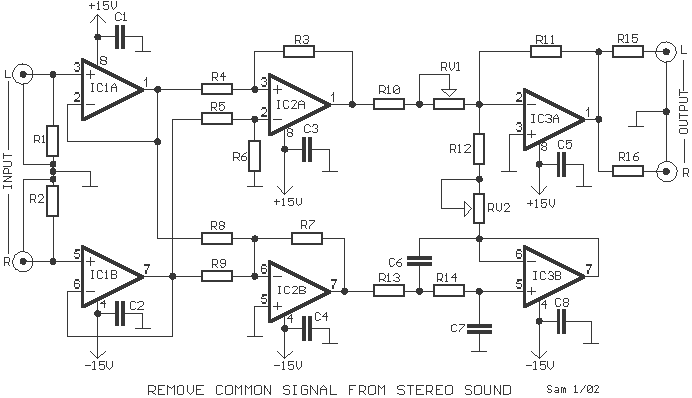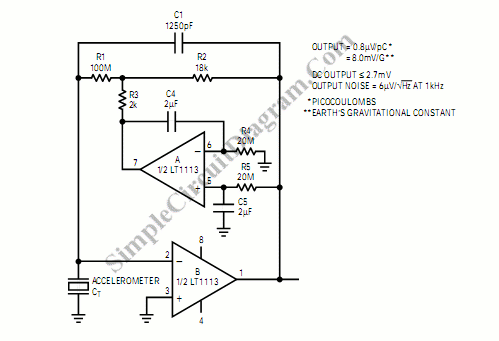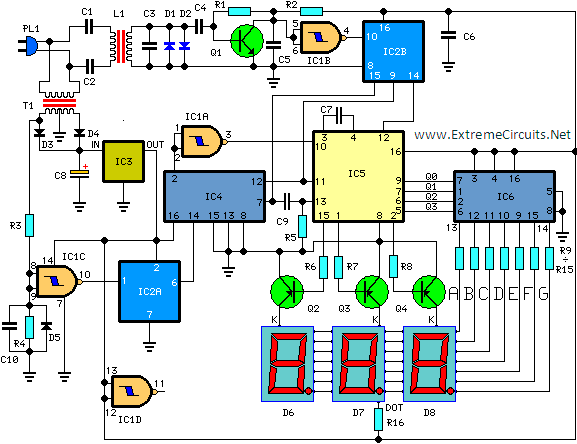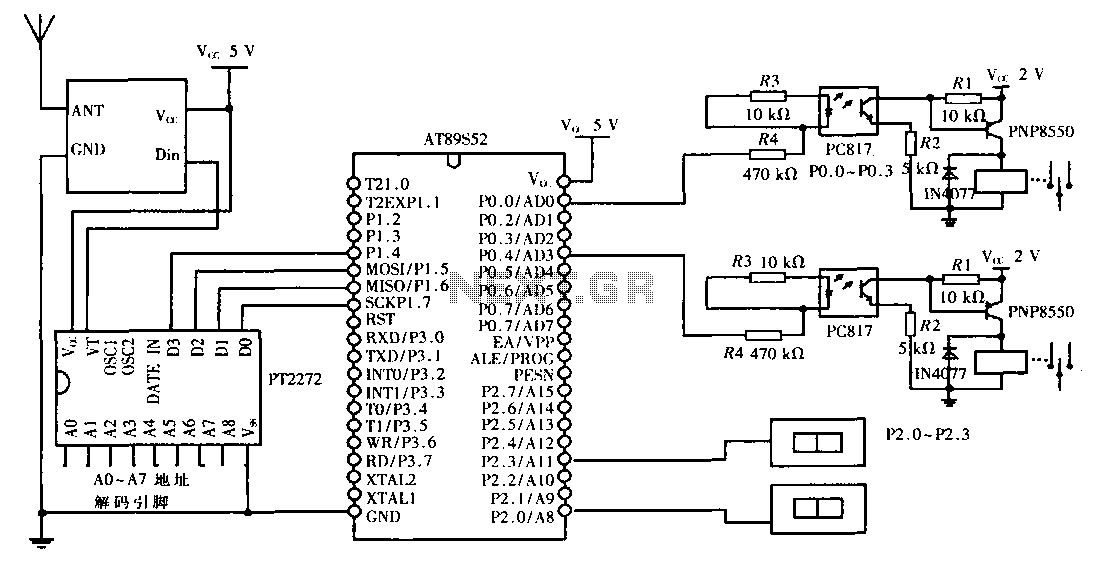
Circuit power audio amplifier stereo with LM1875 and preamp for NE5532 2 x 20 Watts
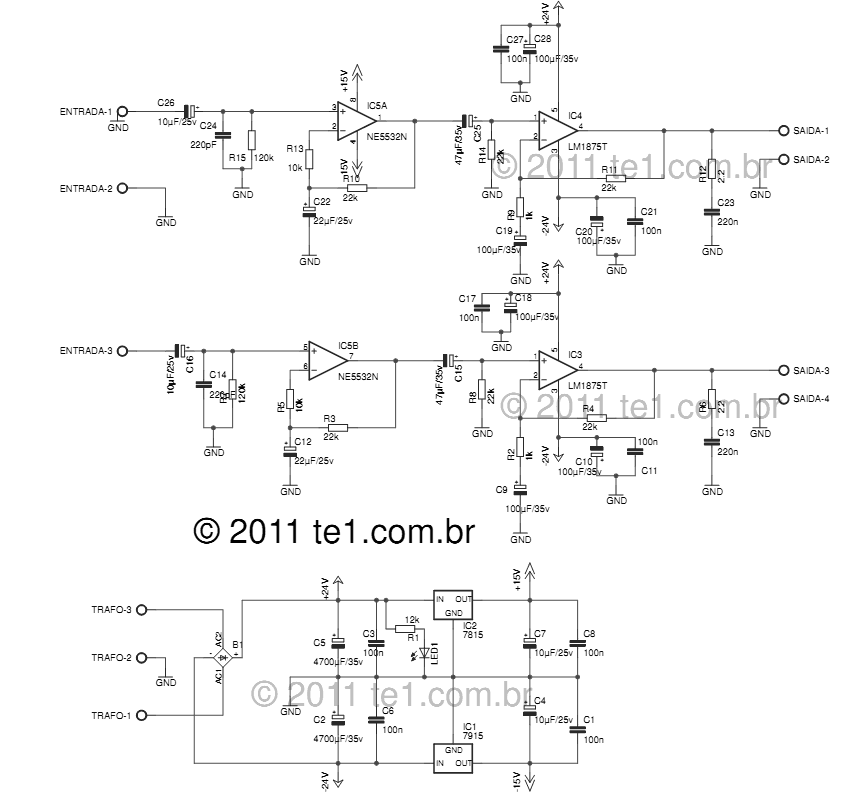
The LM1875 delivers 20 watts into a 4 or 8-ohm load on ±25V supplies. Using an 8-ohm load and ±30V supplies, over 30 watts of power may be delivered. The amplifier is designed to operate with a minimum of external components. Device overload protection consists of both internal current limit and thermal shutdown. The LM1875 design takes advantage of advanced circuit techniques and processing to achieve extremely low distortion levels even at high output power levels. Other outstanding features include high gain, fast slew rate, wide power bandwidth, large output voltage swing, high current capability, and a very wide supply range. The amplifier is internally compensated and stable for gains of 10 or greater. The power supply is symmetrical and easy to assemble; the transformer must be 60VA with 18-0-18 volts in the secondary to achieve a maximum of +25 volts at the power supply. If using 8-ohm speakers, a transformer with up to 22 volts can be used, resulting in approximately 30 watts per channel. B1 is a bridge rectifier that must withstand 100 volts / 4 A, for example, GBU606. The capacitors C2 and C5 can be larger if preferred. The power supply for the preamplifier circuit is based on integrated voltage regulators 7815 and 7915. In addition to the initial source capacitors, there are several capacitors on the supply lines of the integrated circuits. The preamplifier circuit is based on a dual operational amplifier NE5532N. The audio signal is coupled by C26 to pin 3 of IC5A, which amplifies the signal and couples it via C25 to IC4 LM1875. The right channel follows the same configuration. The stereo power amplifier circuit consists of two LM1875 audio amplifiers that allow amplification of up to 20 watts per channel or a maximum of 30 watts at 8 ohms with ±30 volts, connected to 40 watts RMS speakers.
The LM1875 audio amplifier is a highly efficient component capable of delivering substantial power to speakers with minimal distortion. Its design emphasizes simplicity, requiring few external components, which facilitates ease of assembly and integration into various audio applications. The internal mechanisms for overload protection, including a current limit and thermal shutdown feature, enhance the reliability of the amplifier during operation, safeguarding it from potential damage due to excessive heat or current.
The symmetrical power supply design is crucial for optimal performance. The specified transformer, rated at 60VA with a secondary voltage of 18-0-18 volts, ensures that the amplifier receives the necessary voltage to operate efficiently. For configurations utilizing 8-ohm speakers, a transformer with a secondary voltage of 22 volts can be employed, allowing the amplifier to output higher power levels without compromising audio quality.
The bridge rectifier B1, such as the GBU606, is selected for its capability to handle the voltage and current requirements of the circuit, ensuring stable rectification of the AC voltage from the transformer. The choice of capacitors C2 and C5 is also important, as larger capacitors can improve the power supply's filtering capabilities, leading to better performance and stability in the audio output.
The preamplifier stage, utilizing the NE5532N operational amplifier, plays a vital role in preparing the audio signal for amplification. The coupling capacitors C26 and C25 ensure that the audio signal is properly conditioned before it reaches the LM1875 amplifier. This stage is designed to maintain signal integrity while providing the necessary gain to drive the power amplifier effectively.
Overall, the stereo power amplifier configuration, consisting of two LM1875 units, is capable of delivering high-quality audio output suitable for various applications, from home audio systems to professional setups. The combination of advanced circuit design, robust power supply, and effective preamplification results in a versatile and powerful audio amplification solution.The LM1875 delivers 20 watts into a 4 or 8 load on ±25V supplies. Using an 8 load and ±30V supplies, over 30 watts of power may be delivered. The amplifier is designed to operate with a minimum of external components. Device overload protection consists of both internal current limit and thermal shutdown. The LM1875 design takes advanta ge of advanced circuit techniques and processing to achieve extremely low distortion levels even at high output power levels. Other outstanding features include high gain, fast slew rate and a wide power bandwidth, large output voltage swing, high current capability, and a very wide supply range.
The amplifier is internally compensated and stable for gains of 10 or greater. Power supply : This power supply is symmetrical, easy assembly, the transformer must be 60VA 18-0-18 volts in the secondary to have a maximum of + 25 volts at the power supply, if you use speakers of 8 ohms can use up to 22 volt transformer and thus will have about 30 watts per channel. B1 is a bridge rectifier that must withstand 100 volts / 4 A, ex: GBU606. The capacitors C2 and C5 can be longer if you prefer, the power supply for the preamplifier circuit is based on the integrated voltage regulators 7815 and 7915, beyond the initial source of the capacitors, there are number of capacitors on supply lines of integrated circuits.
Pre-Amplifier: This circuit is based on double operational amplifier NE5532N. The audio is coupled by C26, until the pin 3 of ic5A is amplified and coupled via C25 to IC4 LM1875. In the right channel is the same thing. Stereo Power Amplifier: This circuit is based on two integrated circuit LM1875 audio amplifiers that allow amplification of up to 20 watts per channel or 30 Watts maximum @ 8 ohms @ +-30Volts, are connected to speakers 40 Watts RMS. 🔗 External reference
The LM1875 audio amplifier is a highly efficient component capable of delivering substantial power to speakers with minimal distortion. Its design emphasizes simplicity, requiring few external components, which facilitates ease of assembly and integration into various audio applications. The internal mechanisms for overload protection, including a current limit and thermal shutdown feature, enhance the reliability of the amplifier during operation, safeguarding it from potential damage due to excessive heat or current.
The symmetrical power supply design is crucial for optimal performance. The specified transformer, rated at 60VA with a secondary voltage of 18-0-18 volts, ensures that the amplifier receives the necessary voltage to operate efficiently. For configurations utilizing 8-ohm speakers, a transformer with a secondary voltage of 22 volts can be employed, allowing the amplifier to output higher power levels without compromising audio quality.
The bridge rectifier B1, such as the GBU606, is selected for its capability to handle the voltage and current requirements of the circuit, ensuring stable rectification of the AC voltage from the transformer. The choice of capacitors C2 and C5 is also important, as larger capacitors can improve the power supply's filtering capabilities, leading to better performance and stability in the audio output.
The preamplifier stage, utilizing the NE5532N operational amplifier, plays a vital role in preparing the audio signal for amplification. The coupling capacitors C26 and C25 ensure that the audio signal is properly conditioned before it reaches the LM1875 amplifier. This stage is designed to maintain signal integrity while providing the necessary gain to drive the power amplifier effectively.
Overall, the stereo power amplifier configuration, consisting of two LM1875 units, is capable of delivering high-quality audio output suitable for various applications, from home audio systems to professional setups. The combination of advanced circuit design, robust power supply, and effective preamplification results in a versatile and powerful audio amplification solution.The LM1875 delivers 20 watts into a 4 or 8 load on ±25V supplies. Using an 8 load and ±30V supplies, over 30 watts of power may be delivered. The amplifier is designed to operate with a minimum of external components. Device overload protection consists of both internal current limit and thermal shutdown. The LM1875 design takes advanta ge of advanced circuit techniques and processing to achieve extremely low distortion levels even at high output power levels. Other outstanding features include high gain, fast slew rate and a wide power bandwidth, large output voltage swing, high current capability, and a very wide supply range.
The amplifier is internally compensated and stable for gains of 10 or greater. Power supply : This power supply is symmetrical, easy assembly, the transformer must be 60VA 18-0-18 volts in the secondary to have a maximum of + 25 volts at the power supply, if you use speakers of 8 ohms can use up to 22 volt transformer and thus will have about 30 watts per channel. B1 is a bridge rectifier that must withstand 100 volts / 4 A, ex: GBU606. The capacitors C2 and C5 can be longer if you prefer, the power supply for the preamplifier circuit is based on the integrated voltage regulators 7815 and 7915, beyond the initial source of the capacitors, there are number of capacitors on supply lines of integrated circuits.
Pre-Amplifier: This circuit is based on double operational amplifier NE5532N. The audio is coupled by C26, until the pin 3 of ic5A is amplified and coupled via C25 to IC4 LM1875. In the right channel is the same thing. Stereo Power Amplifier: This circuit is based on two integrated circuit LM1875 audio amplifiers that allow amplification of up to 20 watts per channel or 30 Watts maximum @ 8 ohms @ +-30Volts, are connected to speakers 40 Watts RMS. 🔗 External reference

